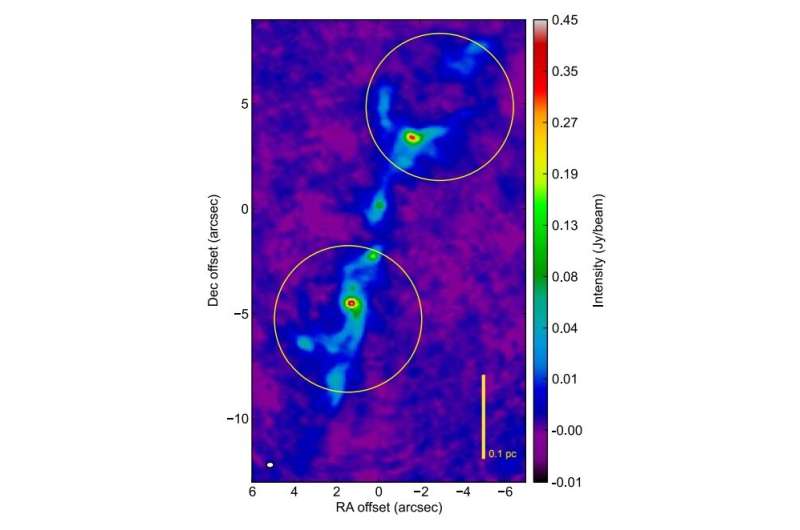May 9, 2019 report
Evolution of magnetic field in the star-forming complex G9.62+0.19 revealed by ALMA

Using the Atacama Large Millimeter Array (ALMA), European astronomers have investigated the magnetic field of the high-mass star-forming region known as G9.62+0.19. Results of these observations, presented in a paper published May 1 on arXiv.org, provide insights into the evolution of this magnetic field, which could help astronomers better understand the role of magnetic fields in the formation of massive stars.
High-mass stars play important role in the evolution of the universe. However, their physical mechanisms of formation are still not fully understood. For instance, one of the debated subjects is how magnetic fields of star-forming regions influence the formation and evolution of such massive stars.
Observations of G9.62+0.19 (G9.62) could help resolve these uncertainties. This well-studied star-forming complex, located some 17,000 light years away, showcases several cores at different evolutionary stages. This region exhibits a fairly well established evolutionary sequence, and high-mass star formation is taking place there on a scale of several light years.
A team of astronomers led by Daria Dall'Olio of Onsala Space Observatory in Sweden decided to observe G9.62 with ALMA, as its capabilities enable tracing magnetic fields even close to the inner parts of the star-forming cores. The observational campaign allowed them to investigate the magnetic field of G9.62 by analyzing its dust emission at 1 mm.
"We aim to determine the magnetic field morphology and strength in the high-mass star-forming region G9.62+0.19 to investigate its relation to the evolutionary sequence of the cores. We make use of Atacama Large Millimeter Array observations in full polarization mode at 1 mm wavelength (Band 7) and we analyze the polarized dust emission," the astronomers wrote in the paper.
ALMA observations allowed the researchers to identify 23 protostellar cores and substructures in G9.62. Fundamental properties of these features were derived, such as their position, peak flux densities, integrated flux, position angles and spectral index. These data uncovered important insights about the region's magnetic field.
"In general, the magnetic field seemed to follow the direction of the filament, and it was perpendicular to the direction of the outflows emitted by some massive protostellar cores such has MM8a, MM7 and MM6. The cores that presented polarisation appeared to be less fragmented than the ones not showing polarised emission. At scales less than 0.1 pc, the magnetic field showed a neat and ordered pattern of polarisation vectors," the paper reads.
Furthermore, the researchers calculated that the strength of the magnetic field is at a level of about 11 mG. They also detected a linearly polarised molecular line, probably emitted thermally by methanol or carbon dioxide.
All in all, the astronomers conclude that high magnetic field strength and the smooth polarised emission suggest that the magnetic field could play an important role in the star-forming processes in G9.62. They emphasized that the magnetic field could influence the fragmentation and the collapse process in this region, adding that the evolution of the cores could be magnetically regulated.
More information: Daria Dall'Olio, et. al. ALMA reveals the magnetic field evolution in the high-mass star forming complex G9.62+0.19. arXiv:1905.00415 [astro-ph.SR]. arxiv.org/abs/1905.00415
© 2019 Science X Network

















